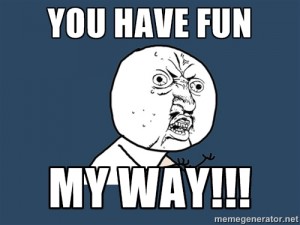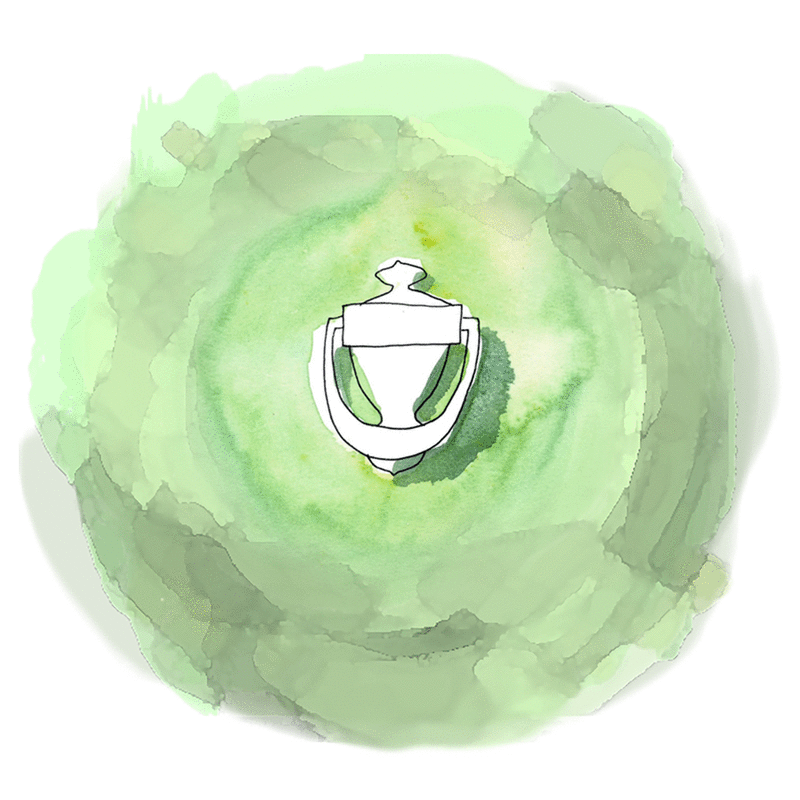
People often bring the Green Door crew on to a project to make it fun. “We want people to be happy. Can we add badges to it? Can we add some graphics? How about points?”
This is known- of course- as chocolate covered broccoli or: gamification. Can we have all the mechanics of a game without it actually being playful? Can we make people do exactly what we want them to do in the way we want them to do it but make it look like they’re enjoying it? Oh boy…

People’s hearts are in the right place: they care about something. Maybe it’s their product or their cause or their business and they want people to enjoy interacting with it. Badges and points seem at first glance like a quick way to make people happy. So actually- making unfun things fun, I do think this is possible. The key is to have clear user goals and then flexibility in getting there. In fact, In my mind, those are only two really serious red flags that can kill the fun in your fun project. Shall I elaborate? Well if you insist:
#1. Unclear User Goals
What do you want people to do? “We want people to just have some fun, reach out to a younger demographic, engage people in 21st century media.” Wait, what does that even mean?? What are we actually trying to achieve? These are probably good “throughlines” or overall big picture things but how do you know when you’ve achieved them? You need to really narrow down what you’re trying to get people to do, don’t waste your players’ time! What are some good goals?
- We want 100 people to visit 5 places in Boston
- We want people to look more closely at these three pieces of art
- We want people to make connections between art and science.
These are things we can actually achieve and we know when we’ve done it. If you REALLY want people to just “have fun” you’d hand them a bottle of beer and a can of silly string and set them loose. I suspect you want something more, so figure out what that thing is and then you can figure out how to achieve it in a playful environment. Now as you may have noticed, if you don’t have clear goals… then just get them. Not impossible. The only deal-breaker is when people refuse to clarify, they cling to vague goals, they list like 20 goals or they keep shifting their user goals.
#2. Inflexible Dynamics
You want to build an app to make people eat healthier food. Great! But it has to have a flower in it and it has to be blue. They have to get points and they have to reach goals and they have to get badges and they have to play on Tuesdays between 12 and 2 and that’s how it is. NOW U GO HAVE FUN!
If we have user goals, we need be flexible on what to do to make them happen in a playful way. Our goal is not to do it OUR way or the way we pictured it, our goal is to do it in the simplest and most achievable way possible. Sometimes you take a look at your user goals, restrictions and resources and find out that what you need isn’t actually a game at all. Maybe it’s a personality profile, branding, a storyline or more instructions. Sometimes you do need a game but the best way to do it would be with a word game or a board game. Your goal is not to build a game- it’s to achieve something through a game. If what you want can be more easily achieved through other media, that’s what you should be doing. (Unless your goal is to build a game… and that’s valid too… but chances are you have to build a game FOR something: you want to get more media, more attention, show your technological abilities, research how games work etc..)
So these flags aren’t a big deal, right? You can totally set clear user goals and then be flexible about how to achieve them! So with that in place, can you make your boring training session/ orientation/ historical tour/ conference fun? Probably. Just be super clear about what you want and then be flexible about how to get there.

So I’m not gonna lie, I like broccoli and chocolate covered broccoli might not be half bad. In fact I think often chocolate covered broccoli is better than no broccoli at all so if badges are the only way you’re going to get your project on the road, go to it.
What do you think? Have you come across these problems before in building or playing? Were they deal-breakers for you as they were for me? Are there other red flags that you’ve seen derail a game design project? Come on readers, I want to hear from BOTH of you! (heheh…)


Leave a Reply